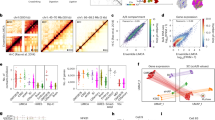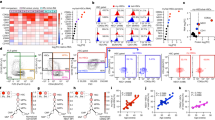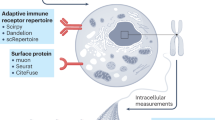Abstract
Developing thymocytes are screened for self-reactivity before they exit the thymus, but how thymocytes scan the medulla for self antigens is unclear. Using two-photon microscopy, we observed that medullary thymocytes migrated rapidly and made frequent, transient contacts with dendritic cells. In the presence of a negative selecting ligand, thymocytes slowed, became confined to areas of approximately 30 μm in diameter and had increased contact with dendritic cells surrounding confinement zones. One third of polyclonal medullary thymocytes also showed confined, slower migration and may correspond to autoreactive thymocytes. Our data suggest that many autoreactive thymocytes do not undergo immediate arrest and death after encountering a negative selecting ligand but instead adopt an altered migration program while remaining in the medullary microenvironment.
This is a preview of subscription content, access via your institution
Access options
Subscribe to this journal
Receive 12 print issues and online access
$209.00 per year
only $17.42 per issue
Buy this article
- Purchase on Springer Link
- Instant access to full article PDF
Prices may be subject to local taxes which are calculated during checkout





Similar content being viewed by others
References
Kyewski, B. & Klein, L. A central role for central tolerance. Annu. Rev. Immunol. 24, 571–606 (2006).
Anderson, M.S. et al. Projection of an immunological self shadow within the thymus by the aire protein. Science 298, 1395–1401 (2002).
Mathis, D. & Benoist, C. Aire. Annu. Rev. Immunol. 27, 287–312 (2009).
Derbinski, J., Schulte, A., Kyewski, B. & Klein, L. Promiscuous gene expression in medullary thymic epithelial cells mirrors the peripheral self. Nat. Immunol. 2, 1032–1039 (2001).
Anderson, M.S. et al. The cellular mechanism of Aire control of T cell tolerance. Immunity 23, 227–239 (2005).
Liston, A., Lesage, S., Wilson, J., Peltonen, L. & Goodnow, C.C. Aire regulates negative selection of organ-specific T cells. Nat. Immunol. 4, 350–354 (2003).
Gallegos, A.M. & Bevan, M.J. Central tolerance to tissue-specific antigens mediated by direct and indirect antigen presentation. J. Exp. Med. 200, 1039–1049 (2004).
Bonasio, R. et al. Clonal deletion of thymocytes by circulating dendritic cells homing to the thymus. Nat. Immunol. 7, 1092–1100 (2006).
Donskoy, E. & Goldschneider, I. Two developmentally distinct populations of dendritic cells inhabit the adult mouse thymus: demonstration by differential importation of hematogenous precursors under steady state conditions. J. Immunol. 170, 3514–3521 (2003).
Gray, D., Abramson, J., Benoist, C. & Mathis, D. Proliferative arrest and rapid turnover of thymic epithelial cells expressing Aire. J. Exp. Med. 204, 2521–2528 (2007).
Ohnmacht, C. et al. Constitutive ablation of dendritic cells breaks self-tolerance of CD4 T cells and results in spontaneous fatal autoimmunity. J. Exp. Med. 206, 549–559 (2009).
McCaughtry, T.M., Wilken, M.S. & Hogquist, K.A. Thymic emigration revisited. J. Exp. Med. 204, 2513–2520 (2007).
Mempel, T.R., Henrickson, S.E. & Von Andrian, U.H. T-cell priming by dendritic cells in lymph nodes occurs in three distinct phases. Nature 427, 154–159 (2004).
Cahalan, M.D. & Parker, I. Choreography of cell motility and interaction dynamics imaged by two-photon microscopy in lymphoid organs. Annu. Rev. Immunol. 26, 585–626 (2008).
Bousso, P. & Robey, E. Dynamic behavior of T cells and thymocytes in lymphoid organs as revealed by 2-photon microscopy. Immunity 21, 349–355 (2004).
Bousso, P., Bhakta, N.R., Lewis, R.S. & Robey, E. Dynamics of thymocyte-stromal cell interactions visualized by two- photon microscopy. Science 296, 1876–1880 (2002).
Bhakta, N.R., Oh, D.Y. & Lewis, R.S. Calcium oscillations regulate thymocyte motility during positive selection in the three-dimensional thymic environment. Nat. Immunol. 6, 143–151 (2005).
Witt, C.M., Raychaudhuri, S., Schaefer, B., Chakraborty, A.K. & Robey, E.A. Directed migration of positively delected thymocytes visualized in real time. PLoS Biol. 3, e160 (2005).
Ladi, E. et al. Thymocyte-dendritic cell interactions near sources of CCR7 ligands in the thymic cortex. J. Immunol. 181, 7014–7023 (2008).
Lindquist, R.L. et al. Visualizing dendritic cell networks in vivo. Nat. Immunol. 5, 1243–1250 (2004).
Schaefer, B.C., Schaefer, M.L., Kappler, J.W., Marrack, P. & Kedl, R.M. Observation of antigen-dependent CD8+ T-cell/ dendritic cell interactions in vivo. Cell. Immunol. 214, 110–122 (2001).
Hadjantonakis, A.K., Macmaster, S. & Nagy, A. Embryonic stem cells and mice expressing different GFP variants for multiple non-invasive reporter usage within a single animal. BMC Biotechnol. 2, 11 (2002).
Ladi, E., Herzmark, P. & Robey, E. In situ imaging of the mouse thymus using 2-photon microscopy. J. Vis. Exp. 25, 652 (2008).
Miller, M.J., Wei, S.H., Parker, I. & Cahalan, M.D. Two-photon imaging of lymphocyte motility and antigen response in intact lymph node. Science 296, 1869–1873 (2002).
Kurts, C. et al. Constitutive class I-restricted exogenous presentation of self antigens in vivo. J. Exp. Med. 184, 923–930 (1996).
Lucas, B. & Germain, R.N. Unexpectedly complex regulation of CD4/CD8 coreceptor expression supports a revised model for CD4+CD8+ thymocyte differentiation. Immunity 5, 461–477 (1996).
Lundberg, K., Heath, W., Kontgen, F., Carbone, F.R. & Shortman, K. Intermediate steps in positive selection: differentiation of CD4+8int TCRint thymocytes into CD4−8+TCRhi thymocytes. J. Exp. Med. 181, 1643–1651 (1995).
McCaughtry, T.M., Baldwin, T.A., Wilken, M.S. & Hogquist, K.A. Clonal deletion of thymocytes can occur in the cortex with no involvement of the medulla. J. Exp. Med. 205, 2575–2584 (2008).
Jung, S. et al. In vivo depletion of CD11c+ dendritic cells abrogates priming of CD8+ T cells by exogenous cell-associated antigens. Immunity 17, 211–220 (2002).
Apostolou, I., Sarukhan, A., Klein, L. & von Boehmer, H. Origin of regulatory T cells with known specificity for antigen. Nat. Immunol. 3, 756–763 (2002).
Haribhai, D. et al. Regulatory T cells dynamically control the primary immune response to foreign antigen. J. Immunol. 178, 2961–2972 (2007).
Bousso, P. T-cell activation by dendritic cells in the lymph node: lessons from the movies. Nat. Rev. Immunol. 8, 675–684 (2008).
Surh, C.D. & Sprent, J. T-cell apoptosis detected in situ during positive and negative selection in the thymus. Nature 372, 100–103 (1994).
Kappler, J.W., Roehm, N. & Marrack, P. T cell tolerance by clonal elimination in the thymus. Cell 49, 273–280 (1987).
Derbinski, J., Pinto, S., Rosch, S., Hexel, K. & Kyewski, B. Promiscuous gene expression patterns in single medullary thymic epithelial cells argue for a stochastic mechanism. Proc. Natl. Acad. Sci. USA 105, 657–662 (2008).
Baldwin, T.A., Sandau, M.M., Jameson, S.C. & Hogquist, K.A. The timing of TCR alpha expression critically influences T cell development and selection. J. Exp. Med. 202, 111–121 (2005).
Akiyama, T. et al. The tumor necrosis factor family receptors RANK and CD40 cooperatively establish the thymic medullary microenvironment and self-tolerance. Immunity 29, 423–437 (2008).
Hikosaka, Y. et al. The cytokine RANKL produced by positively selected thymocytes fosters medullary thymic epithelial cells that express autoimmune regulator. Immunity 29, 438–450 (2008).
Irla, M. et al. Autoantigen-specific interactions with CD4+ thymocytes control mature medullary thymic epithelial cell cellularity. Immunity 29, 451–463 (2008).
Schaefer, B.C., Schaefer, M.L., Kappler, J.W., Marrack, P. & Kedl, R.M. Observation of antigen-dependent CD8+ T-cell/ dendritic cell interactions in vivo. Cell. Immunol. 214, 110–122 (2001).
Acknowledgements
We thank H. Nolla for assistance with flow cytometry; the University of California Berkeley Molecular Imaging Center for microscopy; M. Anderson (University of California, San Francisco) for RIPmOVA mice; L. Ehrlich and R. Lewis for communication of unpublished data; and P. Bousso, B.J. Fowlkes, and members of the Robey laboratory for comments on this manuscript.
Author information
Authors and Affiliations
Contributions
M.L.B. and E.L. designed and did experiments, analyzed and interpreted results and wrote the manuscript; I.D. analyzed the migration of Foxp3-GFP+ cells; P.H. provided technical support for imaging; Y.F.L. did manual scoring and edited tracks; A.K.C. provided guidance for quantitative analysis of cell migration data; and E.A.R. directed the study and wrote the manuscript.
Corresponding author
Supplementary information
Supplementary Text and Figures
Supplementary Figures 1–5 and Supplementary Table 1 (PDF 2960 kb)
Supplementary Movie 1
Thymocyte migration in the cortex and medulla of a cut thymic lobe. Representative runs in the cortex (left) and the medulla (right) of a cut thymic preparation of a WT+OT1→WT chimera showing DCs (CD11c-YFP, orange). The migratory path of 3 representative WT thymocytes (blue) is shown as a time-coded track (blue-red-yellow-white) with the duration of 10.4 min. Yellow arrow points to moving dendrites in the cortex of a cut thymus preparation. Dimensions for each imaging volume: 172 × 143 ×60 μm3 ×10.4 min. White bar represents 30 μm. (MOV 3959 kb)
Supplementary Movie 2
Thymocyte migrating in the medulla during negative selection. Representative runs in the medulla of OT1 thymocytes (green) and CD11c-YFP+ DCs nge) in a WT+OT1→-OVA chimera (left) and a WT+OT1→+OVA chimera (right). Tracks of 3 representative OT1 thymocytes with a duration of 12.5 min (green) are shown. Dimensions for both imaging volumes: 172 × 143 × 62 μm3 × 12.5 min. White bar represents 30 μm. (MOV 3551 kb)
Supplementary Movie 3
Thymocytes are confined to smaller areas in the presence of their negative-selecting ligands. A 3D rotation showing WT thymocyte tracks (blue) and OT1 thymocyte tracks (red) in the medulla of a WT+OT1→+OVA chimera. Dimensions: 172 × 143 ×60 μm3 ×14.6 min. (MOV 1804 kb)
Supplementary Movie 4
Self-reactive thymocytes rarely enter or leave confinement zones. Multiple examples of clusters of auto-reactive OT1 thymocyte tracks. Most of the thymocytes stay in the same confinement zones (colored tracks) during the time of the run (example 1) with some tracks that do not appear to be associated with a cluster (gray tracks). Only a few of cells (red tracks, examples 2-5) are seen entering (yellow circle, examples 3-5) or leaving a cluster of tracks (white circle, examples 4 and 5) while the spending most of the time in a cluster (cyan circle, examples 3-5). Areas highlighted with a white square are magnified to show examples of tracks entering or leaving a confinement zone, with OT1 thymocytes in green and CD11c-YFP+ DCs in orange. Dimensions: 172 × 143 × 60 μm3. White bar represents 30 μm. (MOV 6801 kb)
Supplementary Movie 5
Auto-reactive thymocyte tracks lie between DCs. Two representative 3D rotations showing that most auto-reactive OT1 thymocyte tracks (red) lie between the cell bodies of DCs (orange) in the medulla of a WT+OT1→+OVA chimera. Dimensions: 172 × 143 × 60 μm3. (MOV 3626 kb)
Supplementary Movie 6
Interactions of positive-selecting thymocytes with DCs in the medulla. An example of a single OT1 thymocyte (green) making successive contacts (white circles) with multiple DCs (orange) in the medulla of an OT1→-OVA chimera. In some case, the thymocyte associates closely with the DC body, occasionally turning after contacting the DC. The migratory path is color-coded to indicate time (blue-red-yellow-white). Dimensions: 71 × 72 ×30 μm3 × 20.5 min (MOV 2839 kb)
Supplementary Movie 7
Thymocyte-DC interactions in the medulla during negative selection. An example of a single OT1 thymocyte (green) making successive encounters (circles) with multiple DCs (orange) in the medulla of an OT1→+OVA chimera. The second, longer-lasting contact spans 8.5 min or 56.7% of time. Dimensions: 44.75 × 44.75 × 58 μm3 × 15 min. (MOV 2012 kb)
Supplementary Movie 8
Slow polyclonal thymocytes, like self-reactive OT1, are confined to smaller areas than fast polyclonal thymocytes. 3D rotations showing tracks for all wild-type thymocyte tracks (blue) that are separated into groups of fast (≥8 μm/min) and slow (≥8 μm/min) WT thymocyte tracks (cyan and purple, respectively), as well as OT1 thymocyte tracks (red) in the medulla of a WT+OT1• +OVA chimera. An overlapping zone of confinement containing slow WT tracks and auto-reactive OT1 tracks is highlighted with a white circle while a non-overlapping zone is shown with a yellow circle. Dimensions: 172 × 143 × 60 μm3. (MOV 2787 kb)
Rights and permissions
About this article
Cite this article
Le Borgne, M., Ladi, E., Dzhagalov, I. et al. The impact of negative selection on thymocyte migration in the medulla. Nat Immunol 10, 823–830 (2009). https://doi.org/10.1038/ni.1761
Received:
Accepted:
Published:
Issue Date:
DOI: https://doi.org/10.1038/ni.1761
This article is cited by
-
Factors that influence the thymic selection of CD8αα intraepithelial lymphocytes
Mucosal Immunology (2021)
-
Specialized transendothelial dendritic cells mediate thymic T-cell selection against blood-borne macromolecules
Nature Communications (2021)
-
Recollections of the discovery of promiscuous antigen expression in mTECs
Nature Immunology (2020)
-
Central CD4+ T cell tolerance: deletion versus regulatory T cell differentiation
Nature Reviews Immunology (2019)
-
Live-cell imaging reveals the relative contributions of antigen-presenting cell subsets to thymic central tolerance
Nature Communications (2019)



